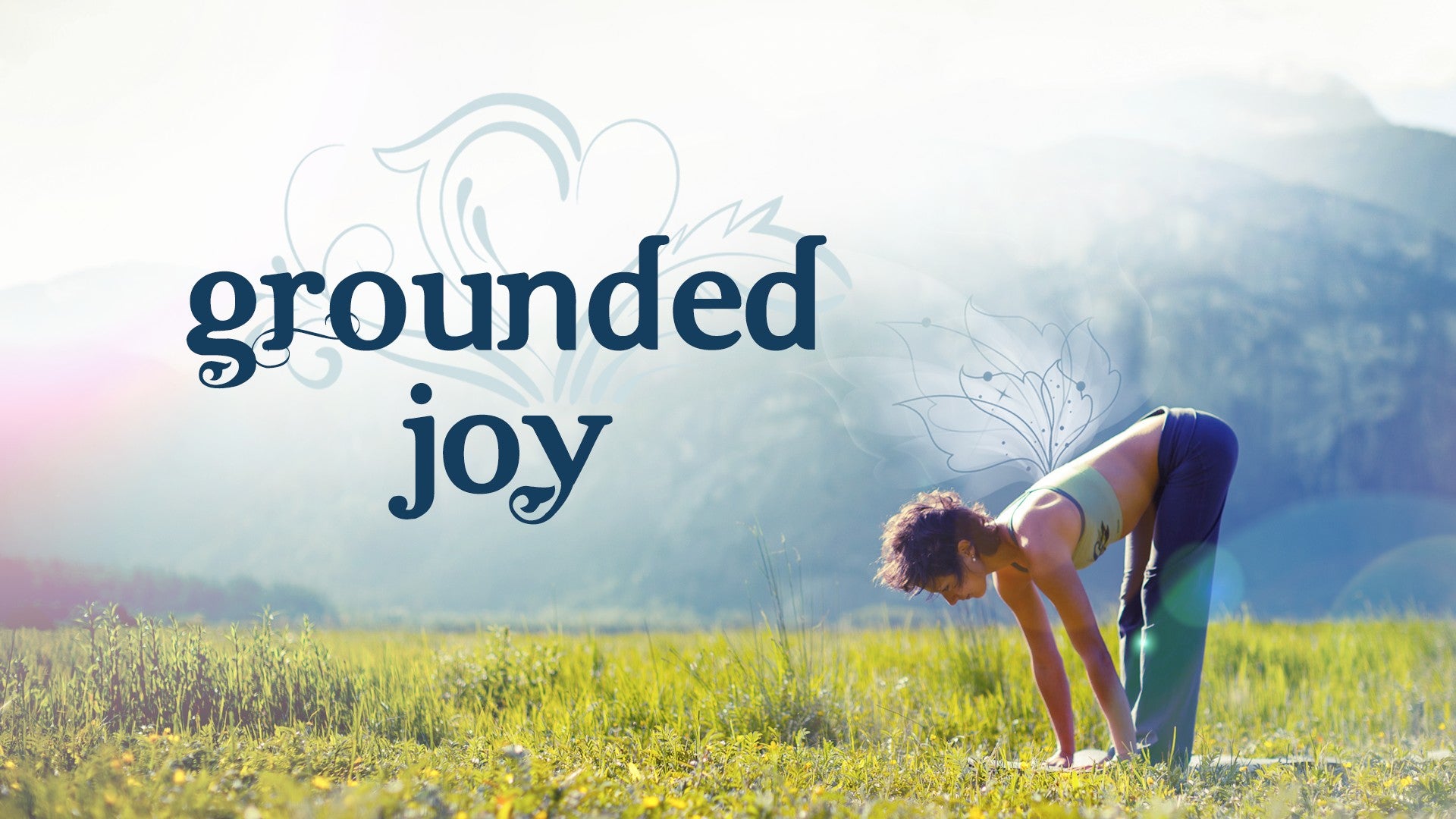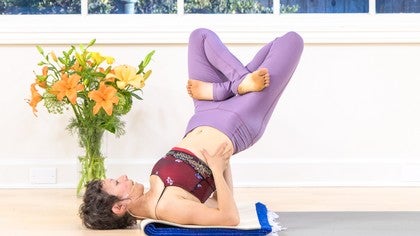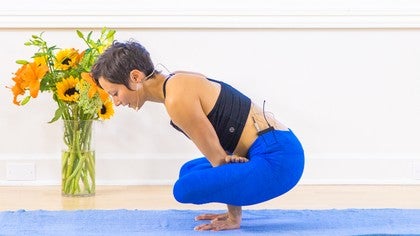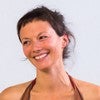Description
About This Video
Transcript
Read Full Transcript
(ocean waves) Hi again. Or maybe for the first time. This is the shoulder stand practice. And I've mentioned this before. It's an afternoon practice, so best done in the afternoon.
And also really best done as the counter pose to the headstand practice. So it's a beautiful practice to link together headstand and then shoulder stand, long Shavasana, in the afternoon. This practice, the shoulder stand practice, is my favorite practice. She's the queen of all the asanas, and she has markedly feminine energy. Super nurturing.
So I feel like the headstand practice is like a dad, throwing his kid up in the air, and it's that kind of energy that's fun and focused and strong. And then, this practice is like a mama putting her baby to sleep. The Shavasana that you get after this practice, for me, and for other of my friends, is the best kind. So it's very deep. Blanket, I'm gonna use one.
You might use two. Make sure, like get kind of intense on not having any wrinkles in your blanket. And I also like the, not the fringy edge of your blanket to be where your head's gonna be. Roll the mat over so you have a sticky surface. And turn around and place the tops of your shoulders at the edge of the mat.
You can slide your shoulder blades down the back a little bit. So I can turn my head here, but I'm actually not gonna turn my head to look at you, my friends, for the rest of this practice because it's not recommended to turn your head when you're upside-down. And I don't want you to do that, either. So, maintain pretty much stable looking up towards your feet, and there's gonna be some variations, but centered skull as much as you can. Two ways to get in to this.
Press down in to your elbows, roll up and catch your hips. One that I really like is actually bridge pose. Kind of walk your shoulders closer underneath you so they're set up elbows nice and close. Take a hold of your hips, maybe come up on to your toe pads to get that. One leg up, then the other, and I'm gonna slide my shirt down 'cause I wanna grab skin with my hands.
You're at home, so maybe that's fine for you, and you don't have to show anyone your belly. But the reason I want skin is because it's more sticky and has friction, and so the movement apart of the elbows won't happen as much. My hands are pointing up my back. Pinky fingers moving up my back. And my chin, I'm just gonna keep a little softness there.
It's not jamming towards my chest. It should feel like in my neck, a little bug could crawl underneath my neck. At least a bug. A cockroach, even. Something a little bit bigger.
So the legs are lifting, but they're not hard. And breathe. You have a nice vantage point of the alignment of your legs. The heels are lifting and the toes are lifting. It's actually a nice practice to talk in shoulder stand, because if you can't speak clearly, it probably means that there's too much pressure on your neck.
You don't have to be straight up and down here. 'Cause sometimes, some people enjoy, like, tipping it back a bit. Ok, so we're gonna come in to Halasana. Your feet might not touch the floor here, so if you wanna bend your knees, and this is quite a deep opening of the back, but I want you to think about actually keeping kind of a feeling of straightening through your spine, pubic bone, sit bones up, almost like someone's lifting you. And because the next posture, Karnapidasana, you'll allow more of a rounding to the spine.
This one you're lengthening a bit more. And so, press your shoulders down so that you feel like the neck is not compressing into the prop and into the ground. So we're gonna go in to Karnapidasana, and we'll separate the knees. Either take them to the temples, or slide them a little bit lower. And it's kinda nice to take your hands around and place them on your calves.
So we'll shift back, and I want you to feel really pressing your shoulders down, and take your hands on your thighs, and lift up your legs a little bit and press your hands in to your thighs and your thighs in to your hands, and really press your shoulders down. So you're shrugging your shoulders in to the floor or the prop. Moving into the Niralamba unsupported shoulder stance. Your shoulders really have to shrug. So this is the first part.
If it feels like you can really shrug the shoulders down, you can maybe lift the legs a little bit higher, maintaining a pressure on the shoulders. It's a little bit rounded in the spine in this one. And then let's take the elbows behind. And I'm gonna walk my shoulders a little closer together, 'cause I feel like they're slipping. Interlock my hands, and this is another Niralamba, unsupported.
Shoulders pressed down, inner and outer biceps pressed down. And then I'm gonna bend and again, find my shoulder stand. So Parsva Eka Pada Sarvangasana, one-legged side shoulder stand. One leg turns into external rotation, and then you let it come out and down towards the floor. And just watch that there's not too much of a separation of your inner legs.
So that as they come together, the two sides of your pubic bone are actually quite even towards the ceiling. This top leg can come back a little bit. And then bring it back up. And then on the other side, externally rotate that leg, and with the toe, follow it out to the side. Try to keep your sit bones fairly level.
This top leg can kick back a little bit. And then Eka Pada, one-legged shoulder stand. One leg goes into plow, and one leg stays up. And as much as you can, keep this sort of zip locking together of the inner line of the legs. And the other side.
Maintain a pressure through the arms and a little bit of a softness through your chin. And then open the legs wide. Roll the hamstrings towards the ceiling, and let the toes come towards the floor if they can. Or bend the knees into wide-legged shoulder stand. Or, sorry, wide-legged plow.
This is more of a plow. So we're gonna take Parsva Halasana, which is a side plow, so we're gonna shift our pelvis into our right hand, which is ready to catch the outer ear of the pelvis. And then take that left leg all the way around to meet the right, and then I can almost, like my head still stays centered, but I can almost lift my left shoulder off of the floor here, and really lean, and breathe in to my left kidney. And I'm just gonna let this left arm release out to the side. So it's not super rounded.
It's nice and long, pubic bone away. This is a really beautiful posture for opening up the back and the sides and the kidneys. So if this is enough for you, stay here. Or you can bend your knees towards the Earth in Parsva side Karnapidasana. And then your left elbow, suck it back to where it used to be, plug it down, and the hand is gonna be ready to catch your sacrum.
So, we're gonna come up with the legs, and let the hand come on to the sacrum. And it's almost like, you need to be quite strong in your fingertips here. So you're coming into side shoulder stand, Parsva Sarvangasana. There's a back bend here. If you don't have the back bend, it's gonna feel really unstable.
And if your wrist doesn't feel that great in this position, you can take a block, yoga block, put it on its high edge, and try it like this. And I actually like to put my hand down my pants here. (laughs) I actually like to put my hand down my pants. (laughs) And because I have skin, and I like to feel that friction. And it's much more supportive, 'cause it's slippery otherwise.
So, we can try this here. If your wrists are ok, your fingers are strong, one leg comes towards you, and the other leg comes away. Bend the leg that's coming away, and tap the floor, and come up and switch. So you might not tap the floor, 'cause you might fall out. It's ok if you fall out.
And you can re-enter at any point. And maybe both, so you can bend and then your legs might even find the floor in Parsva Setu Bandhasana. Side bridge pose. So, strong in the fingers, 'cause it's a lot of flexion in the wrist. Come up on to your toes.
Use your abdominal muscles to bring the legs back in. And then center yourself and come into the plow pose. We're gonna go over to the other side, Parsva Halasana side plow. So, your left hand's ready to catch. And walk your legs over the side.
I like to invert my toes here, and allow the top hip to roll away. This arm can release. Breathing. Softening your eyes. Maybe Parsva Karnapidasana.
Elbow hugs in. You can find your sacrum. There's a back bend here. So there's a rolling open of the chest. And the pubic bone shoots away so that the sacrum is more flat into the palm.
This one's a tricky one to get in to. A lot of times, people try to get in to it like, without the back bend, it's really hard to hold. Difficult to hold. If you're here, and it feels ok on your wrist, you can tap. Tap, and maybe both here.
Parsva Setu Bandhasana. And then use the abdominal muscles to come back up. Into the center, readjust back into shoulder stand. And then, Lotus, upside-down. So, one right foot comes in.
And if your shoulders are shrugging enough, you can use your hand here. So, inner thigh extends into the length. Like that. So hands come on to the knees or the feet, and shrug the shoulders down. So you can soften the neck and think about the C seven coming back in to the skin.
And it's the same thing for the twist now. So we're gonna take the pelvis in the right hand, which is ready to receive it. And find a good grip there with your thumb and your index finger, and then we're gonna allow our Lotus to twist a little bit. And left arm releases. Head stays neutral.
And this kinda gives you a break off of one side, 'cause you shift your weight into the other. And then, left hand elbow pins in again. It's ready to catch your pelvis. And I like to put my right hand on my side here, and then opening up the groins any amount here. So Parsva Padmasana in Sarvangasana.
And then the twist here. You can catch the outer, sort of the hip joint, not even the outer pelvis, but right in the crease of the hip with your index finger and your thumb, and spiral around. Elbow comes in, catch your pelvis. And it's a bit of a back bend, remember, so as you open up the groins here. Inhale, come in to the center.
Exhale, Pindasana, so coming in. And coming up. So, our last thing here is switching sides. So left leg Lotus. You can come out of this at any time.
I'm sure you know that. If this is one of your first times doing this practice, I would recommend only doing a little bit of it, and slowly extending your capacity. So right hand comes to support, and twist. And the left shoulder can almost come off the floor here, if you have the balance, and you get a sense of just really like a breath of fresh air in that side. Because you've been pressurizing your shoulders down for so long, it takes a bit of strength there, for sure.
And then back into the center. Pin the elbow in, find the sacrum. Opening up the front line of the body. Coming in, taking the outer hip here. A little bit of a twist.
And sort of the right shoulder is light. Head is always neutral. Eyes are soft. Elbow in, find the sacrum. Open up any amount.
And then Pindasana, so coming in. Really, this is curly, so make sure the shoulders are pressing. It's nice to support, or you can take your arms around. Ok, so there's two ways to come out of this. One is to release into the plow and roll out.
The one that I really like, so you can do that if you want, or what I really like to come out is to take my thumbs towards my spine here, and come up like this, supporting the outer hips. Let one leg release. Bend the knee, and with a little support from your abdominal muscles coming back towards your spine, find the floor. And sometimes, when it's your first time doing that, you'll plop right down on to the floor, which is fine. And then the other leg comes down.
And it's just nice. This is a mini counter pose. The bridge pose here is this little mini counter pose from all that flexion, and you can lift your chin gently. If you roll out, it's fine as well. It's just a different feeling.
And then, opening up my shoulders, and rolling down gently. And then, you can really basque in the afterglow of the practice here. Close your eyes, just roll your head very gently side to side. Notice how your neck feels, how your back feels, how your arms feel. And coming right in to Shavasana.
So, I'm going to take away this prop situation, and place this blanket over top of me. If you have an eye pillow, or any Shavasana props, then you can take them for this. Lengthening out your spine. Then finding the shoulder blades a little bit sliding away from the neck, and wide. Wiggle the legs in to a release.
You can even rock your heels and just feel that through the whole body. Close your eyes. And with your eyes closed, forget about what you think you should be, or what you think you should look like, or what you think your practice should be like, or what you think your body should be like. Like, all that self doubt. Like, doubt isn't a bad thing, but self deprecation is not a great thing.
Somebody that I'm reading a lot of right now, Anne Lamott, she says, what if you didn't have that kind of time? Like, what if you didn't have that kind of time for all that negative self talk? Like, what if you really had the realization that you don't have that much time for that stuff? And simultaneously, you have endless amounts of time for some things. For life.
Exhale, and go deeper in to a sense of relaxed spaciousness. So you might wanna stay here for quite a bit longer. And it's really nice to take a long Shavasana after this practice. Now, you may feel ready to come out. And if you do, take your time.
To meet me in seated. Namaste.
Grounded Joy
Comments
I'm happy you enjoy this practice! It's very dear to me too. Big hug!
You need to be a subscriber to post a comment.
Please Log In or Create an Account to start your free trial.











